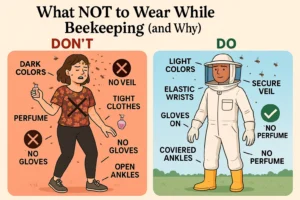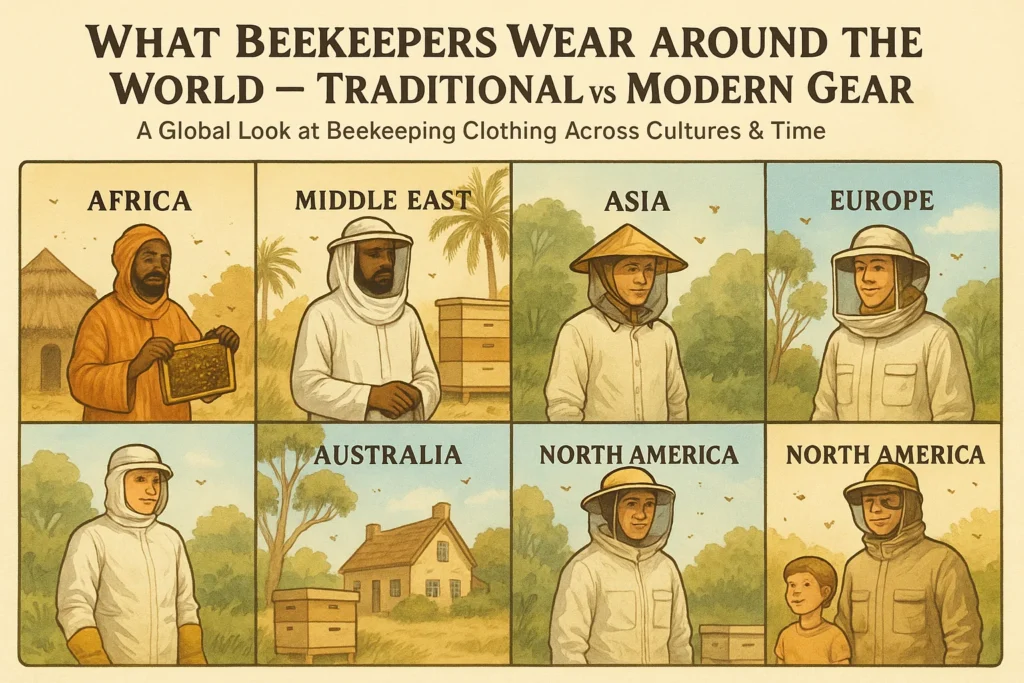
🐝 Gear Up. Stay Safe. Protect the Hive. 🌼

Beekeeping isn’t just a job or a hobby — it’s an ancient relationship between humans and nature. In every corner of the globe, Beekeepers Wear Around styles and fabrics that reflect their climate, culture, and techniques. While the buzz of bees may sound the same everywhere, the outfits tell unique stories.
From the flowing robes of Middle Eastern apiarists to the high-tech ventilated suits of modern cities, this blog dives into the rich contrast between traditional and modern beekeeping clothing around the world. It’s a visual journey that blends history, protection, and personal expression.
🪘 Traditional Attire:
In many African regions like Tanzania, Uganda, and Ethiopia, traditional beekeepers have managed hives for centuries with little or no formal gear. Instead, they relied on:
🛡️ Modern Update:
Now, thanks to government and NGO initiatives, professional beekeepers are adopting ventilated suits to prevent stings from aggressive Africanized bees. However, in rural villages, traditional styles still persist — not from lack of resources, but from inherited skill.
🏜️ Cultural Clothing:
Beekeepers in Yemen, Iran, and Oman traditionally wore long robes (thobes), keffiyehs, and even sandals while tending to hives. These garments weren’t just about modesty — they helped regulate heat in desert conditions.
🔄 The Fusion Gear:
Today’s Middle Eastern beekeepers often mix modern safety with cultural dress. For instance:
It’s a balanced expression of identity and innovation — proof of how Beekeepers Wear Around their heritage while upgrading for safety.

🧶 Old-World Charm:
In places like Germany, Poland, and France, beekeepers historically used:
🚀 Contemporary Gear:
Today, Europe leads in comfort and style:
Now, Beekeepers Wear Around Europe with pride — in stylish suits that merge elegance with protection.
🌾 Traditional Styles:
In China, Nepal, India, and Japan, ancient beekeepers used:
📈 The Modern Shift:
From Japan’s cooling fabric suits to India’s tropical cotton-mesh designs, Asia is embracing gear suited for both agriculture and urban rooftop hives. Yet, traditional garments are still respected — especially in mountainous and forested areas where old wisdom remains strong.
☀️ Climate-Smart Innovation:
Australia faces high heat, intense sun, and occasionally hostile bee strains. To adapt, modern suits now feature:
In contrast, New Zealand’s gear echoes British designs — but with a focus on seasonal comfort and fabric flexibility.

🇺🇸 The Classic Look:
American and Canadian beekeepers have long favored:
🆕 New Trends:
Now the gear scene includes:
Urban beekeeping has also pushed design to be more compact and breathable — ideal for rooftops and balconies.
| Feature | Traditional Gear | Modern Gear |
|---|---|---|
| Fabric | Cotton, wool, handmade | Mesh, poly-blends, vented layers |
| Fit | Loose, flowing | Tailored, ergonomic |
| Headwear | Cloth wraps, straw hats | Sealed veils, anti-fog mesh |
| Gloves | Leather or bare hands | Padded, sting-proof materials |
| Footwear | Sandals, basic shoes | Closed boots, reinforced soles |
| Safety Style | Technique-based defense | Full-body sting resistance |
| Aesthetic | Cultural, plain | Branded, stylish, inclusive |
The way Beekeepers Wear Around the world reflects more than just safety — it reveals values, traditions, and environments. Whether you’re wrapping your head in a keffiyeh, stepping into a triple-layered mesh suit, or donning your grandfather’s handmade gear, your outfit tells a story.
In the end, it’s not just about looking the part — it’s about protecting bees, respecting culture, and connecting with nature through thoughtful design.
So wherever you are — Ethiopia or Texas, Tokyo or Paris — wear your suit with pride. You’re part of a global brotherhood (and sisterhood!) of bee guardians.
